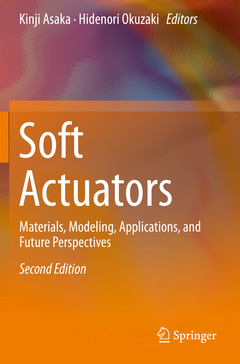Description
Soft Actuators (2nd Ed., 2nd ed. 2019)
Materials, Modeling, Applications, and Future Perspectives
Coordinators: Asaka Kinji, Okuzaki Hidenori
Language: EnglishPublication date: 09-2020
Support: Print on demand
Publication date: 09-2019
740 p. · 15.5x23.5 cm · Hardback
Description
/li>Contents
/li>Biography
/li>Comment
/li>
Part I Introduction
1. Progress and Current Status of Materials and Properties of Soft Actuators
Hidenori Okuzaki2. Current Status of Applications and Markets of Soft Actuators
Kinji Asaka and Kayo Nakamura
Part II Materials of Soft Actuators: Thermo-Driven Soft Actuators
3. Electromagnetic Heating
Takeshi Yamauchi
4. Thermo-Responsive Nanofiber Mats Fabricated by Electrospinning
Hidenori Okuzaki
5. Evolution of Self-Oscillating Polymer Gels as Autonomous Soft Actuators
Ryo Yoshida
6. Polyrotaxane Actuators
Abu Bin Imran, Mohammad Harun-Ur-Rashid, and Yukikazu Takeoka
Part III Materials of Soft Actuators: Electro-Driven Soft Actuators
7. Ionic Conductive Polymers
Kunitomo Kikuchi and Shigeki Tsuchitani
8. Conducting Polymers
Keiichi Kaneto9. Humidity-Sensitive Conducting Polymer Actuators
Hidenori Okuzaki
10. Carbon Nanotube/Ionic Liquid CompositesTakushi Sugino, Kenji Kiyohara, and Kinji Asaka
11. Ion Gels for Ionic Polymer Actuators
Masayoshi Watanabe, Satoru Imaizumi, Tomohiro Yasuda, and Hisashi Kokubo12. Ionic Liquid/Polyurethane/PEDOT:PSS Composite Actuators
Hidenori Okuzaki
13. Dielectric Gels
Toshihiro Hirai
14. Dielectric Elastomers
Seiki Chiba
15. Piezoelectric Polymers
Yoshiro Tajitsu16. Thermal and Electrical Actuation of Liquid Crystal Elastomers/Gels
Kenji Urayama
Part IV Materials of Soft Actuators: Light-Driven Soft Actuators
17. Spiropyran-Functionalized Hydrogels
Kimio Sumaru, Toshiyuki Takagi, Shinji Sugiura, and Toshiyuki Kanamori
18. Photomechanical Energy Conversion with Cross-Linked Liquid-Crystalline Polymers
Jun-ichi Mamiya
19. Photoredox Reaction
Tetsu Tatsuma
Part V Materials of Soft Actuators: Magneto-Driven Soft Actuators
20. Magnetic Fluid Composite Gels
Toshihiro Hirai
21. Magnetic Particle Composite Gels
Tetsu Mitsumata
Part VI Modeling
22. Molecular Mechanism of Electrically Induced Volume Change of Porous Electrodes
Kenji Kiyohara, Takushi Sugino, and Kinji Asaka
23. Computational Modeling of Mechanical Sensors Using Ionic Electro-Active Polymers
Yutaka Toi and Seongwon Yoo
24. Distributed Parameter System Modeling
Kentaro Takagi, Gou Nishida, Bernhard Maschke, and Kinji Asaka
25. Control of Electro-Active Polymer Actuators with Considering Characteristics Changes
Norihiro Kamamichi
26. Motion Design-A Gel Robot Approach
Mihoko Otake
27. Motion Control
Minoru Hashimoto
28. IPMC Actuation Mechanisms and Multi-Physical Modeling
Zicai Zhu, Hualing Chen, and Longfei Chang
29. Sensing Properties and Physical Model of Ionic Polymer
Zicai Zhu, Hualing Chen, and Yanjie Wang
30. Modelling of Dielectric Elastomer Actuator
Bo Li, Hualing Chen, and Guimin Chen
31. Modelling of Dielectric Gel using Multi-Physics Coupling Theory
Bo Li, Longfei Chang, and Yanjie Wang
32. Modeling and Control of Fishing-Line/Sewing-Thread Artificial Muscles (Twisted and Coiled Polymer Fibers, TCPFs)
Kentaro Takagi, Norihiro Kamamichi, Ken Masuya,
Kenji Tahara, Toshihira Irisawa, and Kinji Asaka
Part VII Applications
33. Underwater Soft Robots
Kentaro Takagi, Zhi-Wei Luo, and Kinji Asaka
34. IPMC Actuator-Based Multifunctional Underwater Microrobots
Shuxiang Guo and Liwei Shi
35. Medical Applications
Tadashi Ihara and Taro Nakamura36. Elastomer Transducers
Mikio Waki and Seiki Chiba
37. Dielectric Elastomer Sensors: Development of Stretchable Strain Sensor System
Hideo Otaka
Part VIII Next-Generation Bio-Actuators
38. Tissue Engineering Approach to Making Soft Actuators
Toshia Fujisato, Shunya Takagi, Tomohiro Nakamura, and Hiroshi Tsutsui
39. Integration of Soft Actuators based on a Biomolecular Motor System to Develop Artificial MachinesJakia Jannat Keya, Kentaro Kayano, Arif Md. Rashedul Kabir, and Akira Kakugo
40. Employing Cytoskeletal Treadmilling in Bio-ActuatorsRyuzo Kawamura, Ken-Ichi Sano, and Yoshihito Osada
Kinji Asaka received his Ph.D. degree in Science from Kyoto University in 1990. He is currently a Group Leader of Hybrid Actuator Group, Inorganic Functional Material Research Institute at AIST. His current research interests include interfacial electrochemistry and polymer actuators. He is a member of the Society of Polymer Science, Japan and the Society of Instrument and Control Engineers.
Hidenori Okuzaki received his Ph.D. degree in Science from Hokkaido University in 1994. Since 1994, he has been working on organic electronics using conductive polymers as an assistant professor of the Faculty of Engineering, University of Yamanashi. He has been an associate professor in 2003 and he has dealt with conducting micro- and nano-fibers, and organic field-effect transistors. Since 2014, he has been a professor of the Graduate Faculty of Interdisciplinary Research, University of Yamanashi and he has been focusing on the synthesis of highly conductive polymers and applications to soft sensors and actuators for organic robotics.
Facilitates quick learning with the inclusion of the newest technology and information on basic science and practical applications of soft actuators
Makes generous use of color figures, diagrams, and photographs to provide full descriptions of the mechanism, apparatus, and motion of soft actuators
Inspires readers with new ideas and encourages their research and development, opening up a new field of applications for the utilization and industrialization of soft actuators





